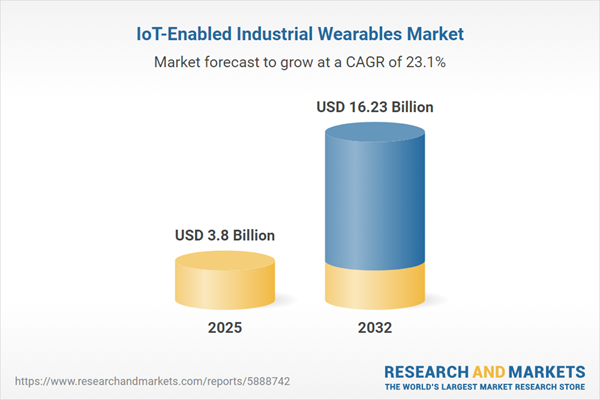Speak directly to the analyst to clarify any post sales queries you may have.
IoT-enabled industrial wearables are rapidly transforming how enterprise operations achieve real-time visibility, safety, and compliance benchmarks. Senior leaders are adopting these technologies to enhance decision-making, improve workforce well-being, and drive sustainable operational advantage in complex industrial environments.
Market Snapshot: Robust Growth in the IoT-Enabled Industrial Wearables Market
The IoT-enabled industrial wearables market is experiencing rapid growth, fueled by expanded adoption across manufacturing, logistics, construction, healthcare, and energy sectors. Recent analysis indicates global revenues are set to rise from USD 3.08 billion in 2024 to USD 3.80 billion in 2025, with projections reaching USD 16.23 billion by 2032—reflecting a compound annual growth rate (CAGR) of 23.09%. This momentum results from sustained investment in connected safety technologies, evolving compliance obligations, and a strong focus on automation. Enterprises are shifting from pilot implementations to full-scale integration of wearables, unlocking measurable improvements in risk mitigation and operational productivity.
Scope & Segmentation: Defining the IoT-Enabled Industrial Wearables Landscape
- End User Industry: Construction, automotive, healthcare, logistics, heavy manufacturing, chemical production, electronics, consumer goods, oil and gas, and food and beverage sectors adopt wearables to elevate safety standards, ensure policy adherence, and drive workforce optimization.
- Product Type: Augmented reality smart glasses, sensor-based gloves, intelligent helmets, ruggedized smartwatches, high-visibility vests, and climate-controlled gear deliver actionable insights to front-line workers in challenging and hazardous environments.
- Technology: Integration of cloud analytics, edge computing, Bluetooth, Wi-Fi, and cellular technologies ensures reliable connectivity and secure, continuous transmission of environmental and biometric data. This backbone supports advanced monitoring capabilities and prompt incident response.
- Component: Dependable hardware, resilient batteries, efficient processors, crisp displays, and robust management platforms enable steady performance and simple integration with current enterprise systems.
- Regional Coverage: Strategic deployment adapts to North America, Latin America, Europe, Middle East and Africa, and Asia-Pacific, each presenting unique infrastructure requirements, regulatory nuances, and digital maturity that shape adoption trajectories.
- Company Analysis: Market innovation and adoption are being advanced by Honeywell International Inc., Zebra Technologies Corporation, Microsoft Corporation, Epson America, Inc., Vuzix Corporation, Google LLC, 3M Company, RealWear Inc., ProGlove GmbH, and TeamViewer AG.
Key Takeaways for Senior Decision-Makers
- Deploying IoT-enabled industrial wearables enhances operational transparency, providing leaders with real-time data to strengthen safety initiatives and streamline workflows.
- Edge computing and robust network connectivity enable organizations managing multiple sites to efficiently coordinate automation programs and uphold regulatory requirements.
- Selecting devices that adhere to interoperable technology standards supports scalability and adaptability, ensuring wearable solutions remain effective as site demands evolve.
- Successful adoption depends on collaboration between technology vendors, businesses, and integration experts to facilitate smooth deployment and maintain employee engagement.
- Customizing rollout strategies according to facility-specific needs and compliance criteria supports higher employee uptake and delivers tangible improvements, particularly in high-risk sectors.
Tariff Impact: Navigating Shifting Supply Chain Dynamics
Recent changes to U.S. tariffs have added procurement challenges and cost pressures for essential wearable components like sensors and processors. Enterprises are mitigating these effects by diversifying supplier networks and utilizing modular hardware architectures to increase agility and resilience. Platform providers are actively evolving their offerings to deliver adaptive software, robust support packages, and business continuity solutions, enabling organizations to manage regulatory obligations and supply fluctuations with greater confidence.
Methodology & Data Sources
This report is based on direct interviews with executive decision-makers, a critical review of current regulatory and sector documentation, and comprehensive analysis of financial filings from leading manufacturers. Additional accuracy is ensured through advanced market segmentation and triangulation.
Why This Report Matters
- Empowers senior leaders to deploy IoT-enabled industrial wearables that are aligned with organizational safety and compliance strategies, driving measurable operational improvements.
- Facilitates seamless system integration while supporting workforce acceptance and ongoing readiness for regulatory changes.
- Supplies actionable regional insights to guide strategic technology investments and strengthen digital transformation efforts across core industries.
Conclusion
IoT-enabled industrial wearables allow organizations to strengthen safety, boost operational resilience, and build long-term capability. Adopting a disciplined deployment framework enables sustainable improvement and readiness for future industrial challenges.
Additional Product Information:
- Purchase of this report includes 1 year online access with quarterly updates.
- This report can be updated on request. Please contact our Customer Experience team using the Ask a Question widget on our website.
Table of Contents
3. Executive Summary
4. Market Overview
7. Cumulative Impact of Artificial Intelligence 2025
Companies Mentioned
The companies profiled in this IoT-Enabled Industrial Wearables market report include:- Honeywell International Inc.
- Zebra Technologies Corporation
- Microsoft Corporation
- Epson America, Inc.
- Vuzix Corporation
- Google LLC
- 3M Company
- RealWear Inc.
- ProGlove GmbH
- TeamViewer AG
Table Information
| Report Attribute | Details |
|---|---|
| No. of Pages | 183 |
| Published | October 2025 |
| Forecast Period | 2025 - 2032 |
| Estimated Market Value ( USD | $ 3.8 Billion |
| Forecasted Market Value ( USD | $ 16.23 Billion |
| Compound Annual Growth Rate | 23.0% |
| Regions Covered | Global |
| No. of Companies Mentioned | 11 |









